Tom's Hardware Verdict
The Xiaomi G Pro 27i has a few calibration quirks that require compromise but with a few tweaks, it delivers a contrasty and colorful image. Its gaming feel is nearly unmatched thanks to a precise overdrive and super low input lag.
Pros
- +
Bright sharp picture in SDR and HDR modes
- +
Huge color gamut
- +
Premium video processing with low input lag
- +
Solid build quality and attractive styling
- +
Phenomenal value
Cons
- -
Calibration requires some compromise
- -
No USB ports or internal speakers
Why you can trust Tom's Hardware
If a gaming monitor’s contrast is vital to your buying decision, there are three main categories to consider. At the low end of the price scale is VA technology. You can expect around 3,000:1 native contrast from a typical VA monitor without spending a lot when it comes to the best gaming monitors.
At the other end of the money path is OLED. There is currently no display tech that has greater dynamic range. But it will cost you. In the middle is Mini LED. Most of these have IPS panels, so you know you’re getting good viewing angles. Some have Quantum Dot layers, which deliver the widest possible color gamut. And if you get one with a lot of dimming zones, the dynamic contrast is much broader or infinite in many cases.
Mini LEDs can also be costly, but prices have been falling steadily thanks to increased competition. Not long ago, a 27-inch QHD Mini LED monitor with 384 dimming zones would set you back $1,000. Xiaomi has broken through several barriers to bring you the G Pro 27i. It’s a 27-inch QHD IPS Quantum Dot panel with 180 Hz, Adaptive-Sync, HDR1000, 1,152 dimming zones and a huge color gamut. And it’s hitting the market at an astounding $390. Let’s take a look.
Xiaomi G Pro 27i Specs
| Panel Type / Backlight | IPS / Mini LED |
| Row 1 - Cell 0 | Quantum Dot Film |
| Row 2 - Cell 0 | 1,152 dimming zones |
| Screen Size / Aspect Ratio | 27 inches / 16:9 |
| Max Resolution and Refresh Rate | 2560x1440 @ 180 Hz |
| Row 5 - Cell 0 | FreeSync and G-Sync Compatible |
| Native Color Depth and Gamut | 10-bit / DCI-P3+ |
| Row 7 - Cell 0 | HDR10, Display HDR 1000 |
| Response Time (GTG) | 1ms |
| Brightness (mfr) | 1,000 nits |
| Contrast (mfr) | 1,000:1 |
| Speakers | None |
| Video Inputs | 2x DisplayPort 1.4 |
| Row 13 - Cell 0 | 2x HDMI 2.0 |
| Audio | 3.5mm headphone output |
| USB | None |
| Power Consumption | 22w, brightness @ 200 nits |
| Panel Dimensions WxHxD w/base | 24.1 x 16-20.8 x 6.7 inches (613 x 406-528 x 169mm) |
| Panel Thickness | 2.4 inches (60mm) |
| Bezel Width | Top/sides: 0.3 inch (8mm) |
| Row 20 - Cell 0 | Bottom: 0.8 inch (20mm) |
| Weight | 15 pounds (6.8kg) |
| Warranty | 3 years |
The G Pro 27i’s 1,152 dimming zones mean dynamic contrast is exceptionally high. I could not measure the black levels in either SDR or HDR modes. Since the zones are so small, there are none of the halo artifacts sometimes seen in full-array backlight displays. Those Mini LEDs also mean high peak brightness. I measured nearly 1,000 nits in SDR mode and over 1,200 for HDR content. The G Pro 27i is certified for VESA DisplayHDR 1000.
A Quantum Dot layer adds significant color volume. Xiaomi claims 99% coverage of DCI-P3, but my sample topped 111%. Accuracy is reasonably good out of the box, but I found a few minor anomalies that I’ll tell you about later.
Gaming is enhanced by a native 180 Hz refresh rate. The G Pro 27i has not been certified by Nvidia, but I had no trouble running G-Sync and FreeSync at its maximum refresh over a DisplayPort 1.4 connection. You get two DisplayPorts and two HDMI 2.0 inputs that support VRR at 120 Hz for gaming consoles.
Despite its low price, Xiaomi does not sacrifice build quality or styling. The G Pro 27i is a solid package with a quality stand and a white finish that stands out among the sea of black monitors we commonly see. A ring of LEDs in the back adds a nice bit of bling. The only features missing are USB ports and internal speakers.
Get Tom's Hardware's best news and in-depth reviews, straight to your inbox.
Quantum Dots, 180 Hz and Mini LED for $390? It almost seems too good to be true, but as I quickly discovered, Xiaomi is very much here to play.
Assembly and Accessories
Xiaomi saves a bit on colored ink by shipping the G Pro 27i in a plain brown carton. You won’t find much besides the monitor in the box which is cushioned with crumbly foam. A wall wart power supply provides the juice, and you get only a DisplayPort cable. The stand is assembled with four bolts that are fixed with the included Phillips head screwdriver. The panel then snaps on.
Product 360
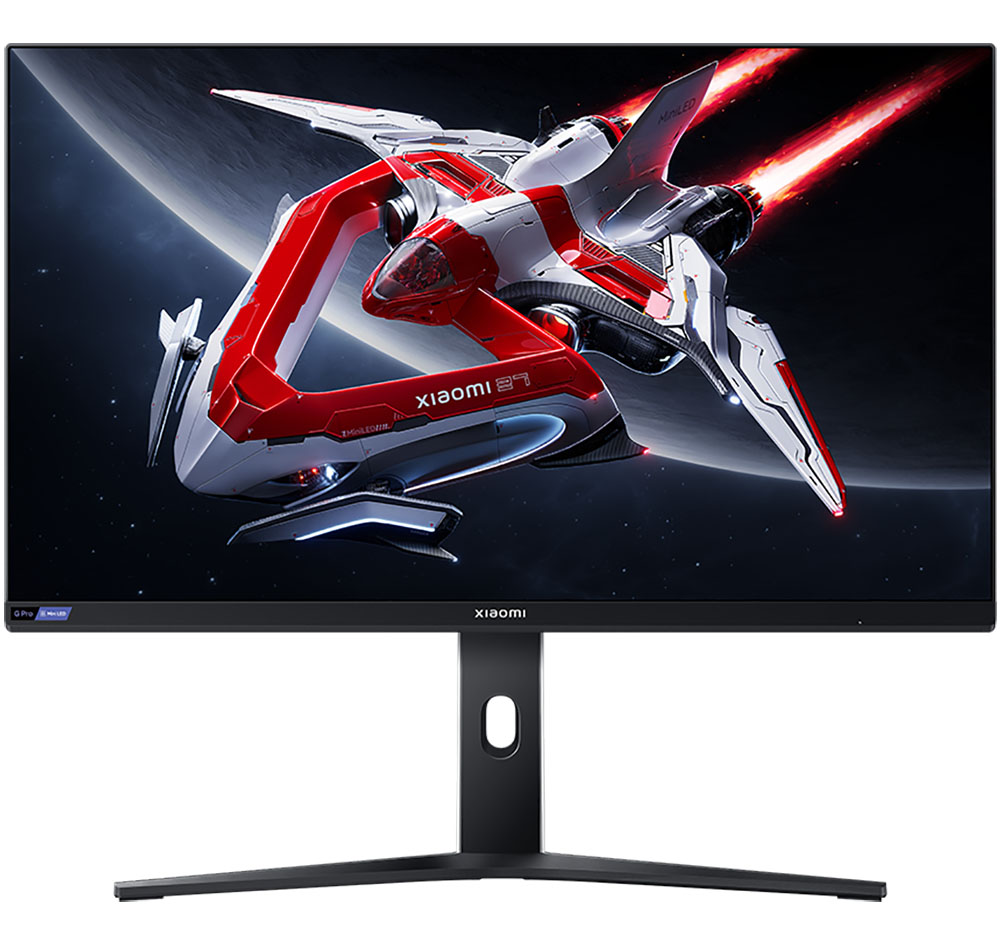
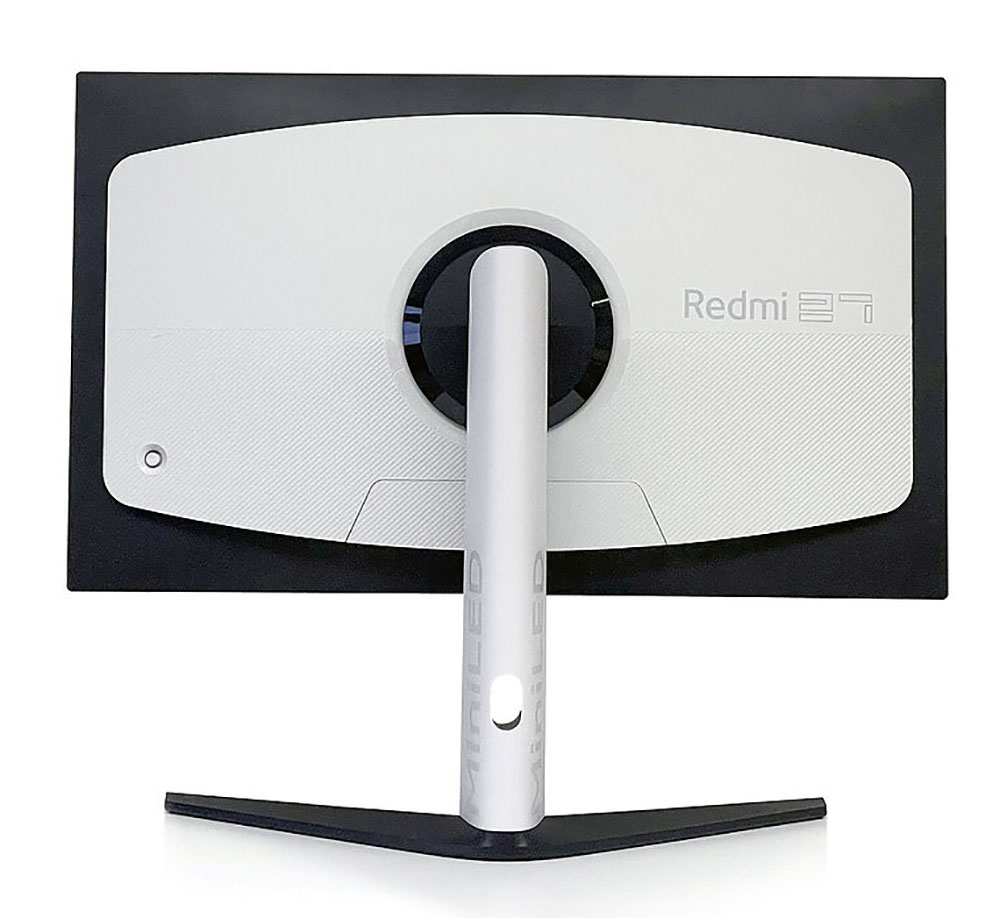
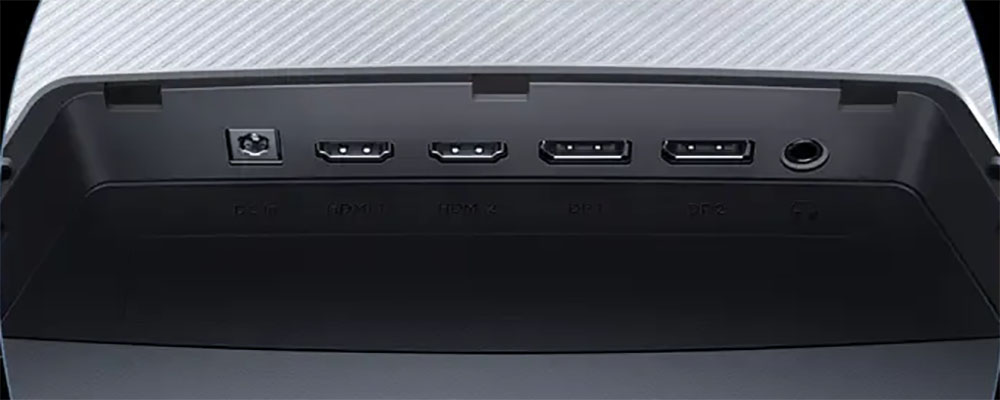
From the front, the G Pro 27i doesn’t call attention to itself. The bezel is flush and narrow, with the only marking being a small Xiaomi logo in white, a G Pro/Mini LED moniker on the left, and a tiny power LED at the right. It glows white, steady for power on, and slow blinking for standby.
Styling is a bit more dramatic in the back with a white upright that announces “Mini LED” in large gray letters and a white rounded rectangle to house the internal components. It says “Redmi 27” so there’s no confusion about screen size. The black circle in the center is ringed by diffused LEDs that can be set to glow in any color.
The stand has a hole for cable management and full ergonomics. Adjustments include 5/20 degrees tilt, 45 degrees swivel, 90-degree portrait mode and 4.8 inches of height. Movements are firm and smooth and better than expected for the price. The G Pro 27i has decent heft as well, and it has a complete package weight of 15 pounds.
The input panel is up and under the center and features two HDMI 2.0 and two DisplayPort 1.4. There is no USB, nor are there internal speakers. You do get a 3.5mm headphone jack though. The power supply is external and rather than the usual brick, it’s a medium-sized wall wart that requires a bit of extra clearance at the outlet.
OSD Features
The G Pro 27i’s OSD has an angular shape that befits a gaming monitor and is all business with signal info at the top and six sub-menus.
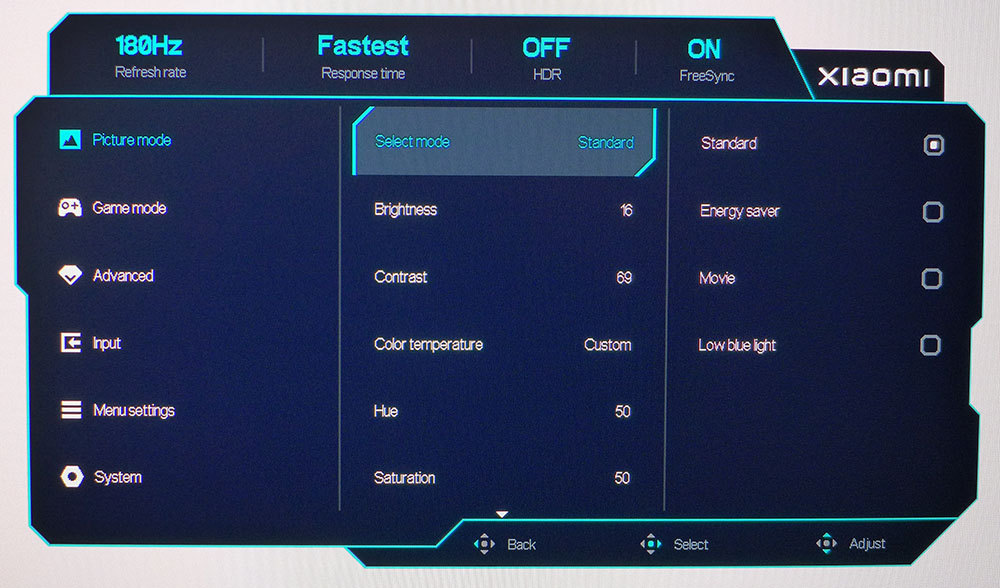
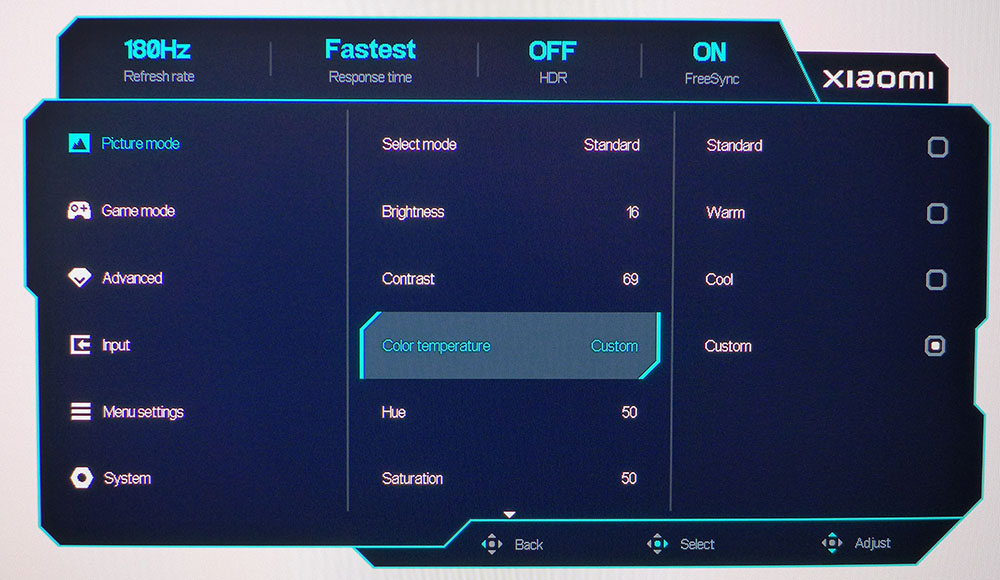
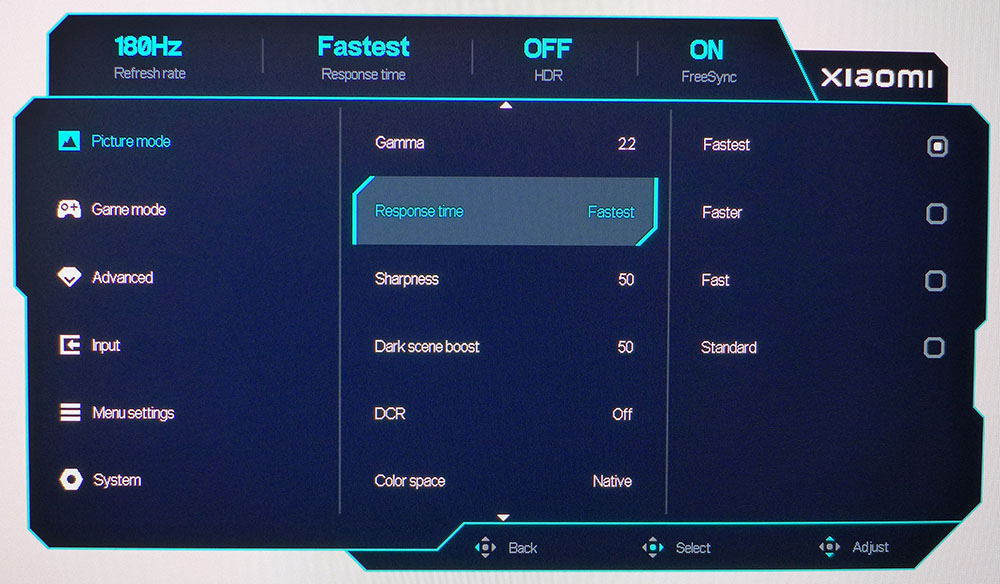
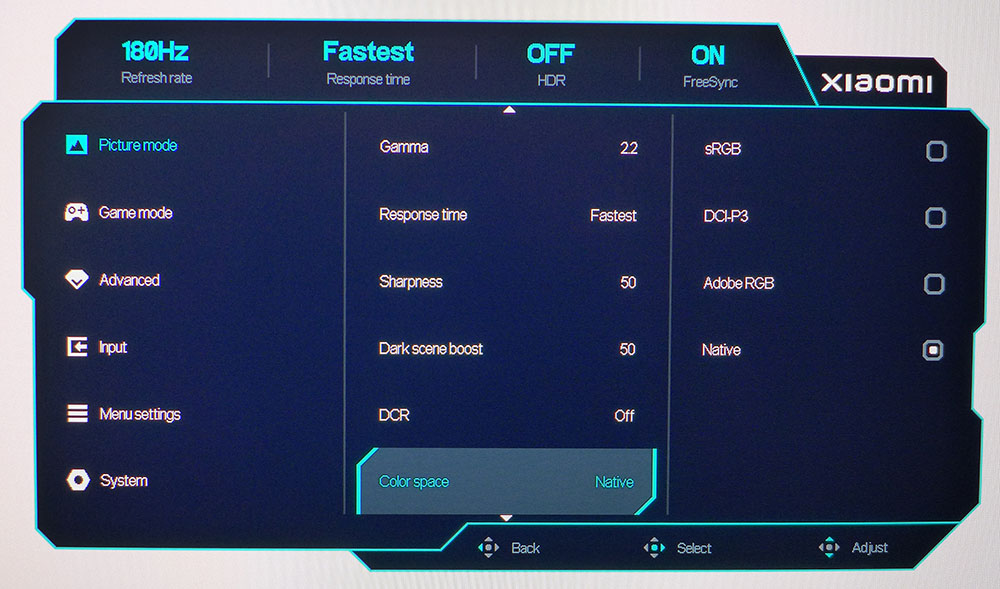
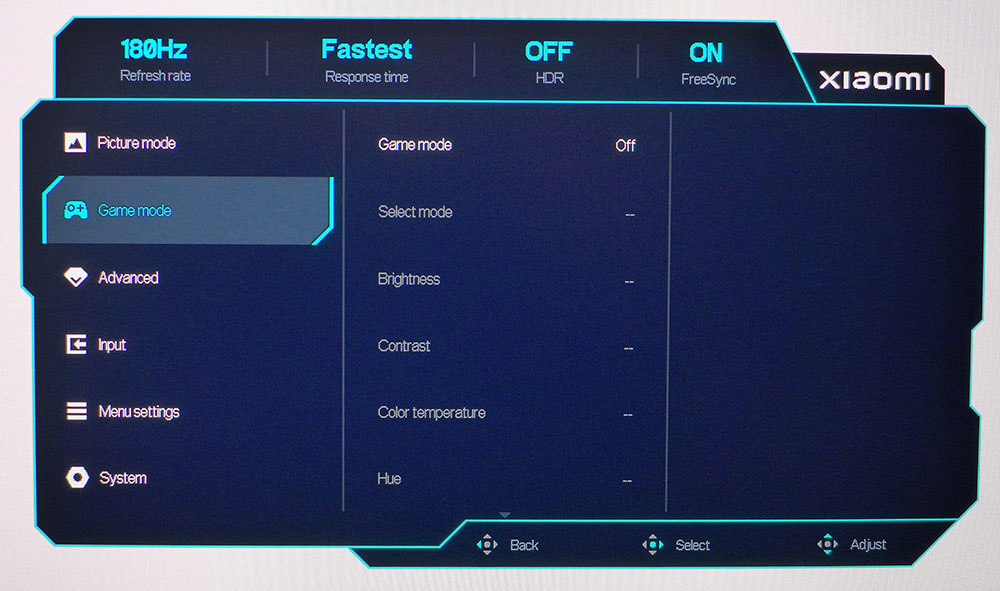
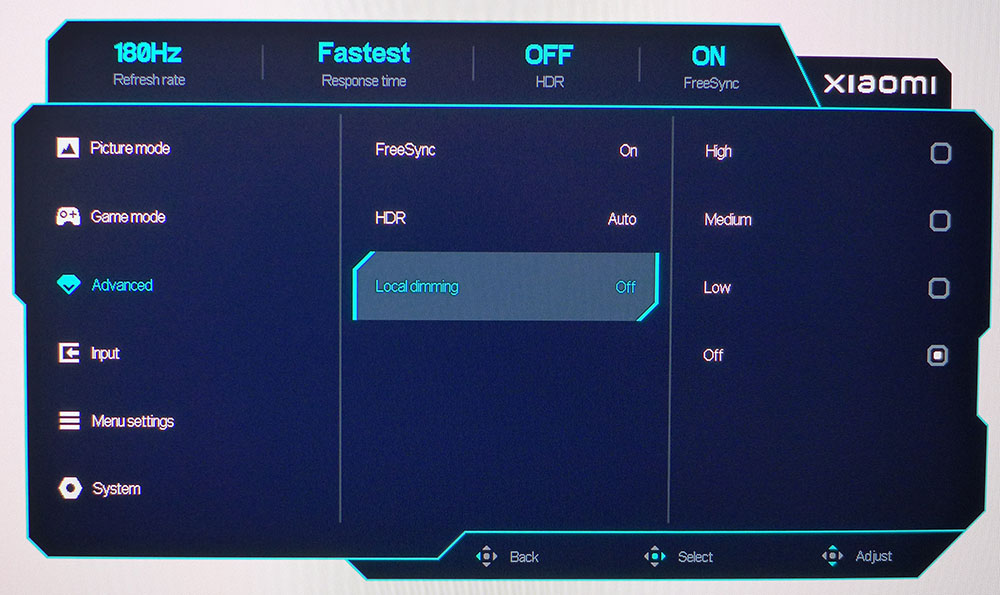
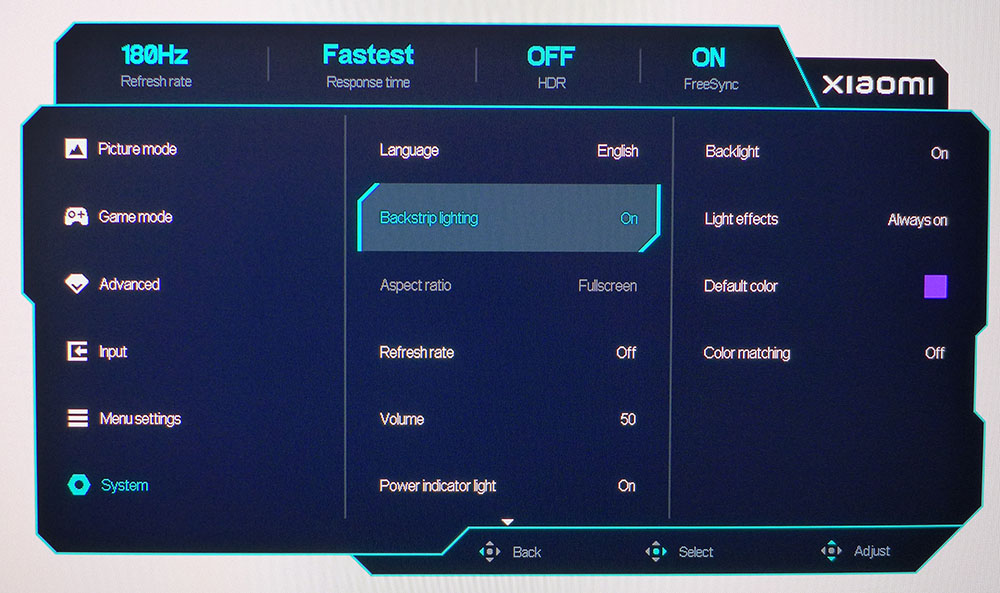
The G Pro 27i has four primary picture modes. I say main because in the second menu, Game Mode, there are four additional modes for specific game types. I saw no advantage to anything other than the default Standard preset, and Game Mode was better left off. I also found some quirks that prevented me from achieving a perfect calibration. I’ll talk more about that later.
There are four color temps and five gamma presets, but there’s a catch. If you want to adjust them, you first have to find the Color Space option on the second page and set it to Native. If you leave it on DCI-P3, Adobe RGB or sRGB, you can’t adjust either color temp or gamma. The good news is that Native, once calibrated, has spot-on grayscale and gamma tracking. But it also has an over-saturated color gamut. I suspect most users won’t mind this. The G Pro 27i is extremely colorful thanks to its Quantum Dot technology.
The G Pro 27i’s overdrive is extremely precise and eliminates almost all motion blur on its Fastest setting. There are no visible ghosting artifacts which is a very good thing. This also makes input lag very low. I saw excellent results in my response and lag tests.
Local dimming is available in both SDR and HDR modes and effectively increases contrast. It also shuts off the backlight completely when displaying a full black pattern so I could not measure the contrast ratio. When you turn it off, the panel hits almost 1,300:1 natively which is higher than the IPS average.
The LED ring on the panel’s backside can be set to different colors and effects. Or you can turn it off if you like. The only other feature I found was a refresh rate indicator that tells you the frame rate in real time. There are no aiming points or sniper modes.
Xiaomi G Pro 27i Calibration Settings
The G Pro 27i comes set to its Standard picture mode with the color space set to DCI-P3. This is reasonably accurate, but I recommend a grayscale calibration to remove a slight blue tone. To do this, you must first set the color space to Native to unlock the color temp and gamma options. Gamma is spot-on so there is no need to change the preset. But you’ll need to tweak the RGB sliders in the Custom color temp as indicated below. The tradeoff is that color is a bit over-saturated in Native mode. But I doubt too many users will complain. The G Pro 27i is very colorful.
For HDR content, the option should be set to Auto with Local Dimming on High. This delivers the best tone mapping and the most impact. There are no color adjustments possible and there is a slight green tint to the mid tones.
| Picture Mode | Standard (Game Mode Off) |
| Brightness 200 nits | 16 |
| Brightness 120 nits | 7 |
| Brightness 100 nits | 4 |
| Brightness 80 nits | 2 (min. 64 nits) |
| Contrast | 69 |
| Gamma | 2.2 |
| Color Temp User | Red 53, Green 50, Blue 50 |
Gaming and Hands-on
The G Pro 27i is an extremely capable gaming monitor. You can certainly buy screens with higher refresh rates and higher resolution, but Xiaomi has achieved truly balanced performance, especially considering the sub-$400 price tag.
It makes the most of its 180 Hz with a top-shelf overdrive. It’s very precise at removing almost all motion blur without causing any ghosting artifacts. It works best on its Fastest setting at 180 fps so a video card that can keep up is essential. That’s not too hard at QHD resolution. The 109ppi pixel density means a sharp picture with a lighter graphics load.
HDR content like Doom Eternal looks superb. This is Mini LED’s forte and the G Pro 27i does justice to the standard with its 1,152 dimming zones. I tried a few test patterns and saw no visible halo effects. Real-world content was very lively and three-dimensional. If you don’t use the local dimming for SDR content, you must turn it on manually when entering HDR mode. Set it on High for the best picture. Lower settings are a bit murky with clipped shadow detail.
In all cases, HDR color was vibrant and saturated without crossing the line into the cartoon look. The G Pro 27i’s wide color gamut is used to full advantage, but not overdone. My sample’s measured color volume was over 111% of DCI-P3 and it showed. It’s clearly more colorful than just about any other monitor.
Local dimming works fine for SDR content as well. It makes black levels deeper without obscuring fine detail. Native contrast is over 1,200:1 so if you’d rather turn it off, the picture is still very satisfying. Spending time in Word and Excel, I had no problems reading tiny text or seeing the fine lines of a spreadsheet grid.
The specific color modes were handy in Photoshop where I could quickly switch between DCI-P3, sRGB and Adobe RGB. The latter mode is something you won’t find on many newer screens, so I was glad to see that Xiaomi included it.
Takeaway: The G Pro 27i is a great all-around display for work and entertainment in both SDR and HDR modes. It’s an even better gaming monitor thanks to its precise overdrive and flawless Adaptive-Sync operation. Input lag is extremely low, enough to qualify it for competition. Resolution and frame rates are well balanced and motion processing is super smooth. Color is vibrant and saturated, and will no doubt make many users happy. And you get all this for $390, impressive!
MORE: Best Gaming Monitors
MORE: How We Test PC Monitors
MORE: How to Buy a PC Monitor
MORE: How to Choose the Best HDR Monitor
Current page: Features and Specifications
Next Page Response, Input Lag, Viewing Angles and Uniformity
Christian Eberle is a Contributing Editor for Tom's Hardware US. He's a veteran reviewer of A/V equipment, specializing in monitors. Christian began his obsession with tech when he built his first PC in 1991, a 286 running DOS 3.0 at a blazing 12MHz. In 2006, he undertook training from the Imaging Science Foundation in video calibration and testing and thus started a passion for precise imaging that persists to this day. He is also a professional musician with a degree from the New England Conservatory as a classical bassoonist which he used to good effect as a performer with the West Point Army Band from 1987 to 2013. He enjoys watching movies and listening to high-end audio in his custom-built home theater and can be seen riding trails near his home on a race-ready ICE VTX recumbent trike. Christian enjoys the endless summer in Florida where he lives with his wife and Chihuahua and plays with orchestras around the state.
-
UnforcedERROR Reply
It's a monitor, so eARC is likely not a thing. That's 100% a TV-to-reciever/sound bar feature.Lucky_SLS said:Does the Monitor support HDMI pass through? Is it eARC? -
Lucky_SLS ReplyUnforcedERROR said:It's a monitor, so eARC is likely not a thing. That's 100% a TV-to-reciever/sound bar feature.
Hmm, here i was thinking it was an HDMI feature. -
UnforcedERROR Reply
HDMI was built for that reason, yes, but eARC specifically is complicated and requires a bunch of handshakes to work. It's really intended to simplify HT setups. HDMI does still pass audio on PC, but to my knowledge most monitors don't do eARC because they're not sending audio signals to other devices, unlike Smart TVs.Lucky_SLS said:Hmm, here i was thinking it was an HDMI feature. -
das_stig CON : No USB ports or internal speakersReply
Not for all, some people don't like to have cables cluttering up their monitor. I myself do like using a monitor for KBD & MSE with a single pass back to the computer, but don't miss internal speakers which are normally poor quality. -
markusveralius1980 Xiaomi's own FAQ states the monitor does not support VRR, but VRR seems to be working fine according to this review. Can someone clarify?Reply -
ammper Reply
On main page Xiomi - xiaomi-mini-led-gaming-monitor-g-pro-27i:markusveralius1980 said:Xiaomi's own FAQ states the monitor does not support VRR, but VRR seems to be working fine according to this review. Can someone clarify?
"FreeSync anti-tearing technology
The computer graphics card and monitor frame rate maintain real-time synchronisation to reduce tearing and lag in dynamic environments.
This ensures smoothness and stability during critical in-game moments." -
pepa3rd Hello, I can't find anywhere if the monitor is Flicker-Free (doesn't use PWM to control brightness).Reply -
MrSayear between these monitors may I ask what u would choose for video editing and media consumption and sometimes gaming because they are on a same price range in my countryReply
Samsung Odyssey G7 S28AG70
Cooler Master GP27Q
Xiaomi g pro 27i
Xiaomi Monitor is actually 60 dollars less than the other monitors and thats a lots of money in my country
If u could answer it would be a huge help
